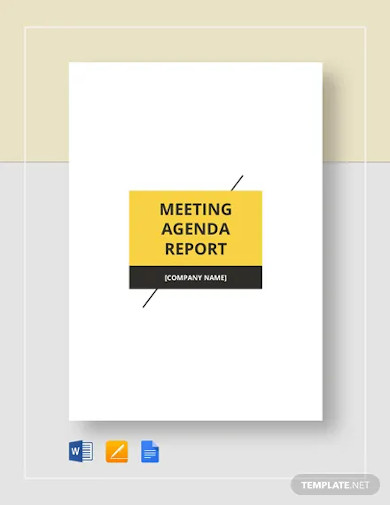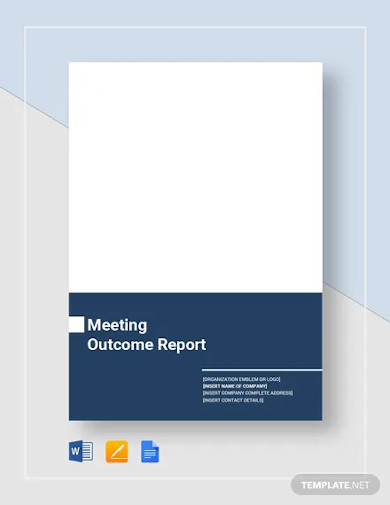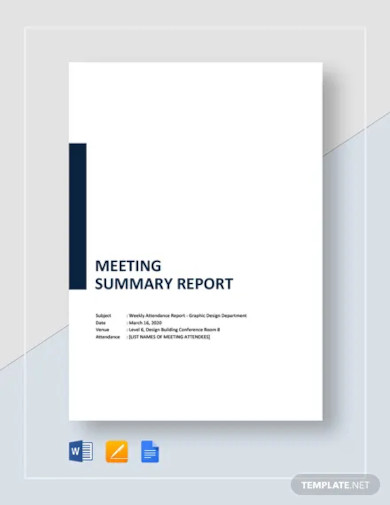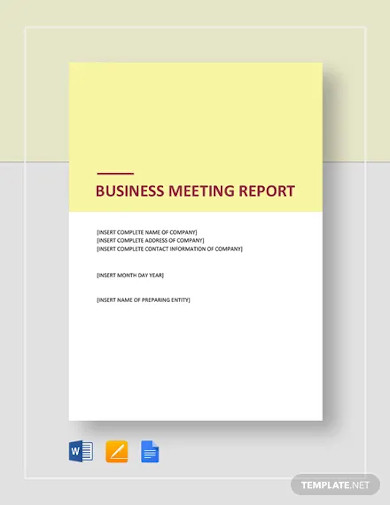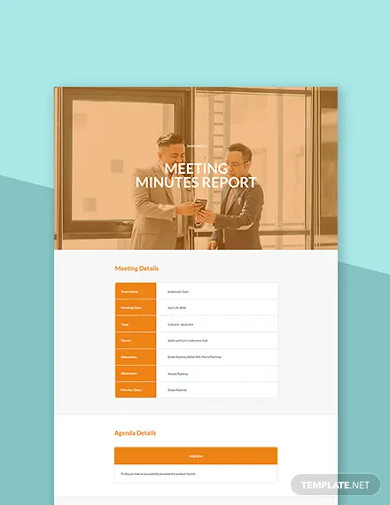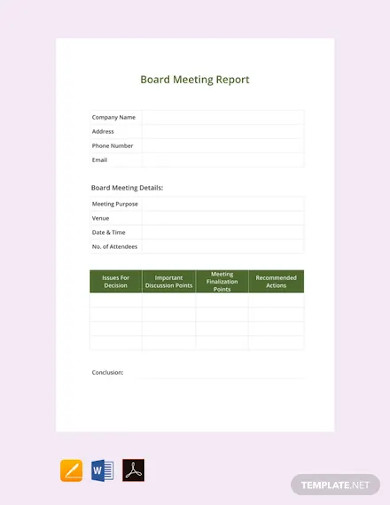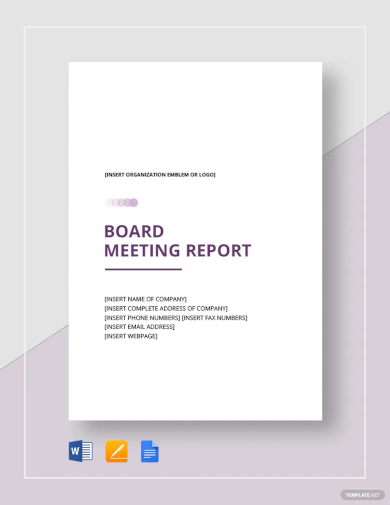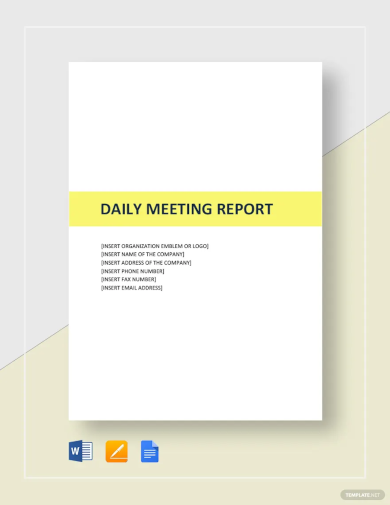12+ Meeting Report Examples to Download
Have you tried attending a company meeting then forgot all the discussions right after leaving the conference room? If that’s the case, you’ll need to brush up on your note-taking skills so you can follow along when collecting the crucial details. But how can you do it well? Several employees and stakeholders are having a hard time where to start in taking down notes or creating meeting reports. In this post, you will learn a few of the best meeting note-taking tips and templates. Scan it now to become the meeting MVP of your company!
12+ Meeting Report Examples
1. Meeting Agenda Report Template
2. Meeting Outcome Report Template
3. Meeting Summary Report Template
4. Business Meeting Report Template
5. Free Meeting Minutes Report Template
6. Free Board Meeting Report Template
7. Board Meeting Report Template
8. Daily Meeting Report Template
9. Meeting Report Template
10. Sample Meeting Report
11. Board Meeting Attendance Report
12. Meeting Report Example
13. Meeting Report in PDF
What Is a Meeting Report?
A meeting report is a document that summarizes the conversation that took place during a given meeting. Different organizations use several kinds of structured meeting notes to keep track of the things they need to execute, recall, and enforce. Meeting reports focus on the essential development discussed and presented at the meeting. Rather than being thoroughly referenced accounts of a sector, they focus more on the work described at the conference.
How To Create a Checklist for Your Meeting Report?
Everyone recognizes that planning will make or break an effective meeting in general. You’ll be more effective and successful if you finish your work before entering the room. However, who has the time to do the whole preparation? And how to create an effective plan for the next meeting?
Below are helpful checklists to make meeting preparation fast and simple.
1. Know the Purpose of the Meeting
The first and most important step for your report is clarifying the purpose of your meeting. What’s your goal? What outcome do you want to achieve? Once you know the reason, it’s time to develop preliminary agenda. Create a timetable for the conference. Plan time for a brief intro to provide context and for the succeeding steps at the conclusion. Determine how much time to devote to each object and the best order to complete them.
2. Choose the Right Participants
After knowing the purpose, it’s time to choose who can help you accomplish your goal. Also, who will benefit from the meeting’s outcome? When presenting a specific topic, consider people who have enough knowledge about it. Be aware of the effects of your conference on people’s schedules around your organization. Only encourage those who absolutely need to be there.
3. Assign Roles To Each Participant
Giving participants a particular role to play will help them concentrate and become more engaged. Each of the characters has a purpose in the meeting. So, assign roles to the participants wisely. Avoid choosing anyone only based on your preferences. Always look for his or her quality and personality.
4. Decide Where and When To Hold the Meeting
The meeting place will help set the mood. If you want your meeting to be relaxed and personal, select a narrow space and group the chairs in a circle. However, if you want it to be formal, the conference room will work best. Make sure that everyone in the audience can hear, participate, and see each other.
5. Send the Invitation and Agenda To Stakeholders and Participants
Once you complete the above steps, consider sending a personal invitation to stakeholders and participants. They must be aware of the purpose of the meeting. As such, you can now focus on the materials needed and your own presentation.
FAQs:
What’s the difference between a report of a meeting and meeting minutes?
The distinction between a report of a meeting and a meeting’s minutes is that minutes are more formal and comprehensive, while a summary of a meeting is shorter and only covers the highlights. The meeting’s minutes, but some companies are still using reports.
Why is a meeting report necessary?
It’s definitely not a stretch to say that taking minutes at a corporate meeting is the last thing you or your team needs to do. However, it’s a significant and sometimes required job. The following are the reasons to take note of some thorough minutes at your next meeting:
- Legal Protection
- Provide Structure
- Dive Action
- Measuring Stick
- State Ownership
What’s the purpose of meeting minutes?
Meeting minutes are a tool to document the actions taken by meeting participants. Contrary to popular belief, taking meeting minutes does not entail “taking notes” or transcribing what is being during the meeting. Meeting minutes should explain the details stated at the meeting.
If you want to get free meeting report templates, don’t hesitate to download our samples now! We also have business activity report samples that you might also need.
12+ Meeting Report Examples to Download
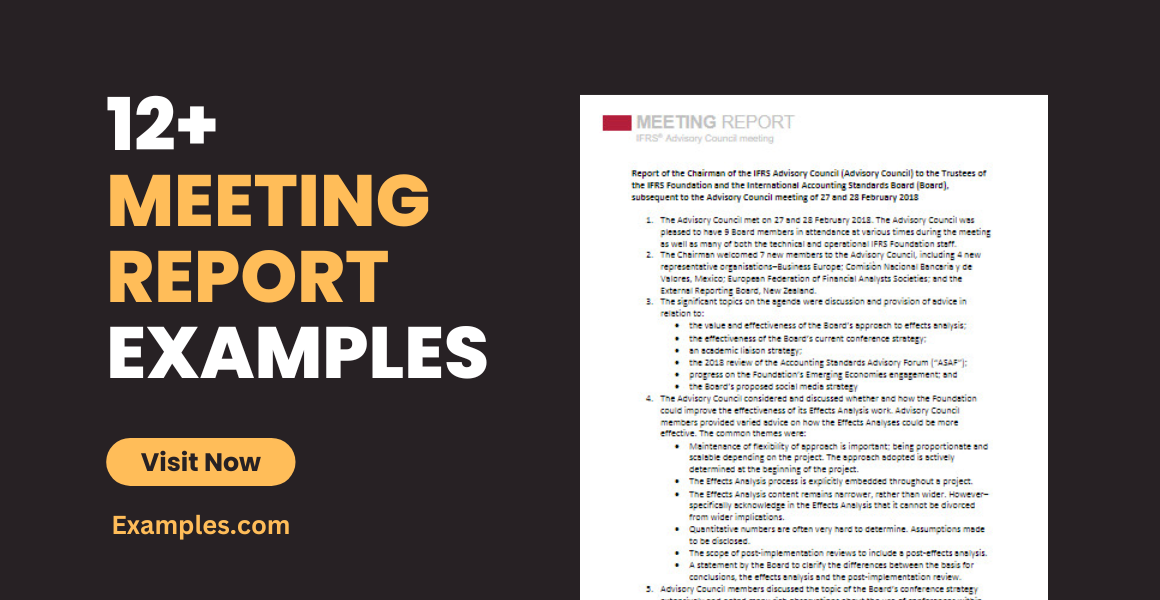
Have you tried attending a company meeting then forgot all the discussions right after leaving the conference room? If that’s the case, you’ll need to brush up on your note-taking skills so you can follow along when collecting the crucial details. But how can you do it well? Several employees and stakeholders are having a hard time where to start in taking down notes or creating meeting reports. In this post, you will learn a few of the best meeting note-taking tips and templates. Scan it now to become the meeting MVP of your company!
12+ Meeting Report Examples
1. Meeting Agenda Report Template
Details
File Format
MS Word
Pages
Google Docs
Size: A4, US
2. Meeting Outcome Report Template
Details
File Format
MS Word
Pages
Google Docs
Size: A4, US
3. Meeting Summary Report Template
Details
File Format
MS Word
Pages
Google Docs
Size: A4, US
4. Business Meeting Report Template
Details
File Format
MS Word
Pages
Google Docs
Size: A4, US
5. Free Meeting Minutes Report Template
Details
File Format
MS Word
Google Docs
Size: A4, US
6. Free Board Meeting Report Template
Details
File Format
MS Word
Pages
PDF
Size: A4, US
7. Board Meeting Report Template
Details
File Format
MS Word
Google Docs
Apple Pages
PDF
Size: 42 KB
8. Daily Meeting Report Template
Details
File Format
MS Word
Google Docs
Apple Pages
PDF
Size: 38 KB
9. Meeting Report Template
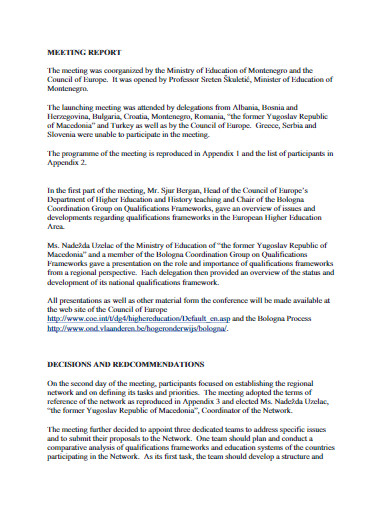
coe.in
Details
File Format
PDF
Size: 515 KB
10. Sample Meeting Report
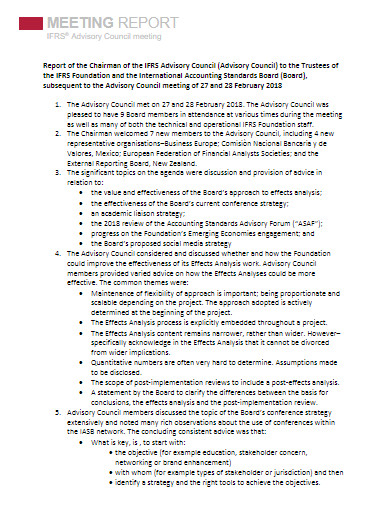
cdn.ifrs.org
Details
File Format
PDF
Size: 113 KB
11. Board Meeting Attendance Report
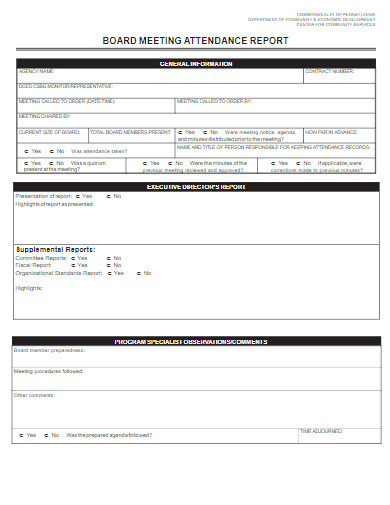
thecaap.org
Details
File Format
PDF
Size: 144 KB
12. Meeting Report Example
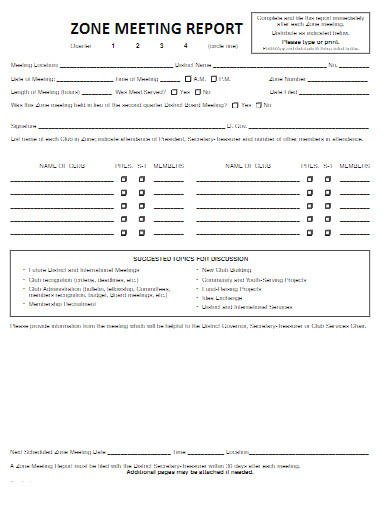
optimist.org
Details
File Format
PDF
Size: 104 KB
13. Meeting Report in PDF

washdata.org
Details
File Format
PDF
Size: 1 MB
What Is a Meeting Report?
A meeting report is a document that summarizes the conversation that took place during a given meeting. Different organizations use several kinds of structured meeting notes to keep track of the things they need to execute, recall, and enforce. Meeting reports focus on the essential development discussed and presented at the meeting. Rather than being thoroughly referenced accounts of a sector, they focus more on the work described at the conference.
How To Create a Checklist for Your Meeting Report?
Everyone recognizes that planning will make or break an effective meeting in general. You’ll be more effective and successful if you finish your work before entering the room. However, who has the time to do the whole preparation? And how to create an effective plan for the next meeting?
Below are helpful checklists to make meeting preparation fast and simple.
1. Know the Purpose of the Meeting
The first and most important step for your report is clarifying the purpose of your meeting. What’s your goal? What outcome do you want to achieve? Once you know the reason, it’s time to develop preliminary agenda. Create a timetable for the conference. Plan time for a brief intro to provide context and for the succeeding steps at the conclusion. Determine how much time to devote to each object and the best order to complete them.
2. Choose the Right Participants
After knowing the purpose, it’s time to choose who can help you accomplish your goal. Also, who will benefit from the meeting’s outcome? When presenting a specific topic, consider people who have enough knowledge about it. Be aware of the effects of your conference on people’s schedules around your organization. Only encourage those who absolutely need to be there.
3. Assign Roles To Each Participant
Giving participants a particular role to play will help them concentrate and become more engaged. Each of the characters has a purpose in the meeting. So, assign roles to the participants wisely. Avoid choosing anyone only based on your preferences. Always look for his or her quality and personality.
4. Decide Where and When To Hold the Meeting
The meeting place will help set the mood. If you want your meeting to be relaxed and personal, select a narrow space and group the chairs in a circle. However, if you want it to be formal, the conference room will work best. Make sure that everyone in the audience can hear, participate, and see each other.
5. Send the Invitation and Agenda To Stakeholders and Participants
Once you complete the above steps, consider sending a personal invitation to stakeholders and participants. They must be aware of the purpose of the meeting. As such, you can now focus on the materials needed and your own presentation.
FAQs:
What’s the difference between a report of a meeting and meeting minutes?
The distinction between a report of a meeting and a meeting’s minutes is that minutes are more formal and comprehensive, while a summary of a meeting is shorter and only covers the highlights. The meeting’s minutes, but some companies are still using reports.
Why is a meeting report necessary?
It’s definitely not a stretch to say that taking minutes at a corporate meeting is the last thing you or your team needs to do. However, it’s a significant and sometimes required job. The following are the reasons to take note of some thorough minutes at your next meeting:
Legal Protection
Provide Structure
Dive Action
Measuring Stick
State Ownership
What’s the purpose of meeting minutes?
Meeting minutes are a tool to document the actions taken by meeting participants. Contrary to popular belief, taking meeting minutes does not entail “taking notes” or transcribing what is being during the meeting. Meeting minutes should explain the details stated at the meeting.
If you want to get free meeting report templates, don’t hesitate to download our samples now! We also have business activity report samples that you might also need.


